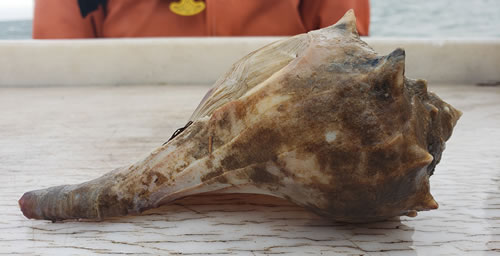By Brielle Colledge, Wildlife Worker
Marine Fisheries Administration
January 27, 2020
New Jersey's showpiece attraction is its beautiful white sandy beaches. Our coastline stretches 130 miles, from Sandy Hook to Cape May, the oldest seaside resort in the nation. But with beauty comes destruction. New Jersey's shoreline is decreasing every year due to coastal erosion. Coastal erosion is the result from strong winds and currents (produced during hurricanes and nor'easters) pulling sand from the beaches.
Have you ever wondered, where sand comes from? It can come from various places. Sand is formed when rocks are broken down due to weathering and eroding over thousands or even millions of years. So, the sand you're building your sand castle with is from rocks that were around during the dinosaur age! But before sand makes its way to the ocean it starts off as a rock up streams or rivers. As the rock makes its way down a stream or river it is constantly breaking apart into smaller pieces. Once it makes its way to the ocean, waves and the tide will continue to erode the rock.
At the beaches around Sandy Hook you will notice the sand is very coarse. If you head south and visit the beaches near Atlantic City, you will notice the sand's texture is smooth. However, if you visit Cape May's beaches on the Delaware Bay you will notice pebbles and the sand is much coarser. You may even find large quartz, also referred to as Cape May Diamonds. The reason for differing sands is due to the irregularity of the beach structure and shoreline, water depth and the physical characteristics of the ocean bottom in front of the beach. Different strengths of wave and current activity play a role in the sand's texture. Areas with high impact wave activity will have a finer granular sand texture. Areas with low wave activity, like the Delaware Bay, will have a more course/pebble texture. Even though parts of New Jersey have different textures of sand, the entire coast has similar shells and small crustaceans.
Did you know New Jersey has its own state shell? There are only fourteen states in the United States that have a state shell. New Jersey's state shell is the knobbed whelk, Busycon carica. Similar species to the knobbed whelk are the channeled whelk, Busycotypus canaliculatus and lightning whelk, Busycon sinistrum. The knobbed and lightning whelk look very similar to one another. The lightning whelk's opening is on the left side, where the knobbed and channel whelk's opening is on the right side. Do you know what animal is the original home owner to these beautiful shells? Not a hermit crab, but a sea snail. Whelks are the largest sea snails off New Jersey's coast.
 
|
Knobbed whelk
Click images to enlarge
|
 
|
Channeled whelk
Click images to enlarge
|
 
|
Lightning whelk
Click images to enlarge
|
When walking along the beach have you ever seen a strange, spiral structure? It's actually an egg casing! These are the egg casings of whelks, and inside each disk is a bunch of tiny little whelks As these sea snails grow, their shells grow with them. A whelk's shell can reach up to nine inches long. However, when they die they leave behind their shells. The shells then become homes for other marine life such as hermit crabs or a hiding place for an octopus.
 
|
Whelk Egg Casing and Small Whelk Shells
Click images to enlarge
|
Here is a list of some common creatures and shells you may come across while visiting New Jersey's beaches. Click on a group name to view individual species:
The next time you're out walking the beach, keep your eye out for one of the many wonders of nature that New Jersey's beaches offer!